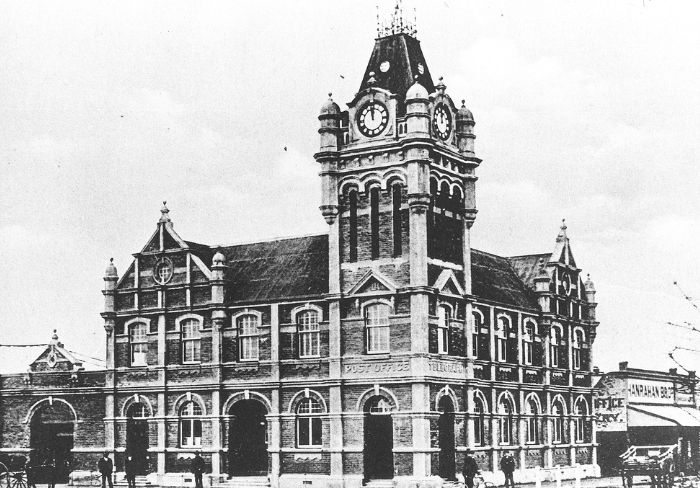Before the digital age, town clocks were regarded as an integral part of the community, and Ashburton was no exception.
Not only did their regular chiming of the quarter hours serve to ensure that all who resided within the boundaries kept accurate time, but they were also considered a unique symbol of community identity.
The clock is installed
Prior to 1900, Ashburtonians utilised a modest wooden post office, and a town clock with chimes, which was located at the public library and borough council building.
When the old post office was destroyed by fire, a new one befitting the prosperity and growth of the town was erected, sturdily built of brick and Oamaru stone and complete with an imposing clock tower.
On May 30, 1900, the borough council mooted that the existing town clock be re-installed at the newly built post office.
This suggestion was rejected by the postmaster general, deeming that the old borough clock was not suitable to be installed in the new clock tower.
With that decision, the four-year search for a suitable clock, and the funds to pay for it, commenced.
Local ratepayers, a government subsidy, and the borough and county councils all contributed to the total cost of obtaining a suitable clock, priced at £1500 (approximately $350,000 today.)
The new Ashburton clock was installed at the Post & Telegraph Office and was started on February 8, 1904, by the wife of Mayor Davis, much to the satisfaction of the councillors of the time.
The former borough clock had its chime removed, to avoid both confusion and cacophony in the ears of the local community.
The tune of the clock’s chime, known as Westminster Quarters, originated from the church of St Mary the Great in Cambridge, England, first heard in 1783.
The words set to the tune, still played every hour are: “Lord, through this hour, Be Thou our guide, And, by Thy power, No steps shall slide.”
The clock disappears
Following the 1931 Hawkes Bay and 1942 Wairarapa earthquakes, the decision to demolish Ashburton’s post office tower was made by the director-general of the Post and Telegraph Department in January, 1944.
Every effort was made by the civic authorities to save the structure, and to retain the clock, but the efforts were unsuccessful.
This edict caused great consternation within the Ashburton community. Protests and petitions were launched, with three major points of debate: locals had financed the clock, so felt “ripped off” by the bureaucrats; it was considered that there was no likelihood of earthquakes in the area; and the absence of the regular chimes would cause disruption to all those who set their timepieces by the clock. Despite their best efforts, the tower was dismantled, and the clock relegated to storage in 1946.
While a chiming device was reinstalled in the old borough clock, the desire for the presence of the large chiming clock, along with accompanying tower, never abated among locals.
Reinstated
As early as 1950, council had instigated a clock tower committee to investigate the erection of a tower which would also serve as a World War Two memorial.
While the memorial was incorporated into the existing cenotaph at Baring Square West, the patient quest to reinstate the clock tower continued.
During the 1970s, members of the Ashburton Lions Club restored the timepiece, working in Ralph Crum’s home workshop every Monday night for a year.
This prompted the council to mark the 1976 Ashburton County Centennial by erecting a suitable tower to re-house the clock, as part of the Baring Square East revamp.
At 4pm on November 26, 1976, at Baring Square East, the clock and its chimes sprung back into action. Crowds of people gathered to hear the clock and chimes ring across Ashburton yet again, some no doubt remembering the controversy surrounding its removal 30 years earlier.
The tower itself received an Enduring Architecture award from the New Zealand Institute of Architects in 2004.
Following the Canterbury Earthquakes of 2011/12, the new tower was deemed an earthquake risk like its predecessor and a seismic upgrade was undertaken, along with a renovation of the clock mechanism itself.
Today of course a communal chiming clock is not the timekeeping necessity it once was, blessed as we are with a variety of accurate methods of keeping time which do not necessitate counting the local chimes. However, I for one find the chiming of the clock extremely comforting.
Its illuminated faces and various colours light up dark mornings and evenings.
The chimes remind me of the people who also heard them in days gone by.




